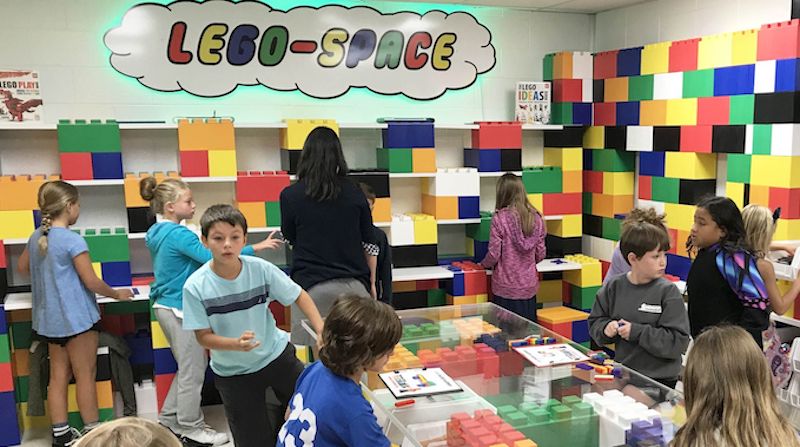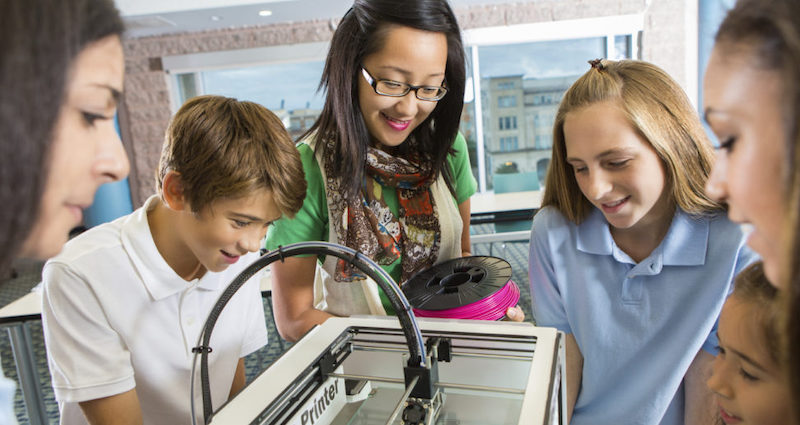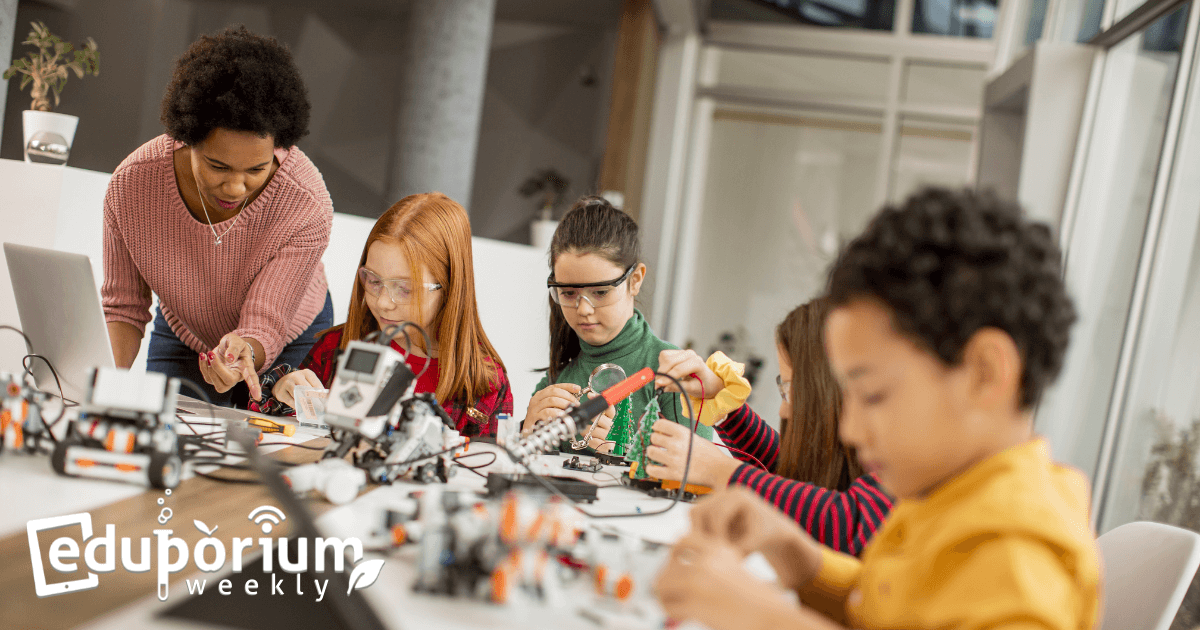Makerspace learning can provide children with some truly transformational opportunities. Whether they are using any high-tech equipment or fashioning a last-minute project with materials they find in the immediate area, capturing the true spirit of the Maker Movement can help so many children see how they can create genuine connections to real-world problem solving. More significantly, maker education isn't strictly geared towards students of any one age group. It's also perfect for helping educators supplement the curriculum across every grade level and helping children develop creativity and collaboration skills. Whether it's in first grade or 12th grade, maker education is a potential game changer for student engagement.
Designing a Makerspace for Elementary Students
Makerspaces are great for enabling creative learning because there aren't many rules or restrictions within them. Typically, teachers get to remind students that designing and inventing in a makerspace is their own personal opportunity to truly express themselves and create something that's relevant to them. This is one of the reasons why makerspaces are popular in the elementary grades. Of course, these younger students are still grasping the value of creativity and collaboration but they tend to know that they'd love to arrive at a point at which they feel satisfied with what they've created. In providing an area for elementary students to practice creative problem solving through hands-on exploration, designing a makerspace could even help transform the school community and the values students share with each other.
Supporting student curiosity.
Especially in elementary school, students are extremely curious and it's extremely valuable to capitalize on that natural curiosity. Sometimes, all it takes is posing one general question and just letting students get to work. With various makerspace tools at their disposal, children tend to enjoy expressing various thoughts and whatever pops into their heads in a slew of unique ways, which is what maker learning is all about. It's also likely that children will have dozens of different ideas for designing projects or solving challenges. This, of course, is great and it's important for educators to support and uplift these ideas. Plus, with each project your elementary students create, there is an opportunity for teachers to remind them how they can use this kind of ingenuity to benefit the whole community.
Inspiration, design, and problem solving.
Sometimes, inventing is all about capitalizing on a spark. Teachers can help students generate innovative ideas through conversations and dialogue. Once they have something with potential, it's often effective to encourage them to start designing a prototype right away. When students create a great idea—whether in the makerspace or the general classroom—beginning on the design process while it's fresh in their minds often leads to opportunities to create something truly transformative. With elementary students, this helps them take on new challenges that may or may not tie into the curriculum. Essentially, children just need to see that there is almost always a creative way to solve a problem and following a structured approach for doing so is often effective and enjoyable.
How to Launch an Elementary Makerspace
If you're focusing on introducing elementary school students to maker learning, it could potentially involve a more simplistic start. At this age, students won't necessarily need (or want) anything that is too complex. If these experiences provide an exciting break from what they do every day, then you're often off to a great start. Another advantage is that so many different experiences could be part of maker education—from the kids getting creative with arts and crafts to using recycled materials for building sculptures to incorporating electronics and coding. Even when creating a makerspace in elementary school, however, it is important to first form a mission. This helps students recognize the importance and the opportunity in front of them and promotes learning through exploration and play. Plus, educators can incorporate core concepts from many different subject areas.
The makerspace, the mission, and the tools.
We've shared plenty of tips to starting a school makerspace and it truly begins with determining where it will be. Regardless of student ages, your makerspace doesn't have to be fancy and doesn't have to be big. In fact, new makerspace instructors can often get away with repurposing an existing space, like the library. At least at the start, it's not so much about the room students have or the tech tools available to them. It's more about coming together, spreading a consistent message on how they'll enjoy the space, and starting to build a community. Once the space is set, then teachers can fill it with maker tools. It's not solely up to teachers, however. Because maker learning is community-based, makerspace facilitators may prioritize kids finding and contributing materials for the projects. It's then that the true spirit of the Maker Movement, combined with upcycling, is on display.
How to interest students in MakerEd.
It's not just about using repurposed materials to make projects, however. Showing students that they can also repurpose materials to make other things they need in order to enable those projects, like the stands, display shelves, or a dedicated work area, is another way to capture the essence of makerspace learning. With this maker mindset spreading around, your makerspace will likely serve these kids well. From there, it's simply about generating some school-wide buzz and inviting all students. Like we said, most of them will be excited about trying something they consider more fun than learning. But, if they need convincing, they shouldn't take long to discover how much fun they can have tinkering and collaborating. Just don't feel too afraid to try!

Makerspace Ideas for Middle School
Moving up to those students who are a bit older, making in middle school can be an amazing experience. While it's great if these kids have had some previous MakerEd experiences in elementary school, they are certainly not required for introducing them to the benefits of maker education. Also, at this age, students even benefit from having a makerspace class as part of their core curriculum or elective offerings. If it's an actual class as opposed to an extracurricular activity, it might help them better understand its significance. Additionally, educators could then teach core concepts and soft skills, including design thinking, planning, and collaboration before students start making.
Design thinking in the makerspace.
When children are engaged in maker learning, it's the perfect chance for teachers to also introduce design thinking and the design process. This helps them learn how to work together from the initial conception of a project, up through the planning stages, and into both the development and execution phases. Breaking maker projects and inventions down into structured processes helps students minimize apprehension and maximize the impact of their projects. Since so much of maker education involves designing projects that help to solve greater problems, this is key. So, starting with reviewing the importance of design thinking is great for students at this age.
Station rotation, the maker process, and empathy.
Like in other grades, there's no need to create a makerspace middle school curriculum. If you believe you have the resources and knowhow to do it, however, that would be perfectly fine. If you're going for a more experience-based approach, designing purposeful makerspace projects is a favorite among teachers. One of these strategies involves using station rotation, which is a common instructional approach in classrooms as well. This enables kids to apply new design thinking skills in a process-based way and form empathy for those they're working with as well as those they are working to create a solution for. As they rotate through the different stations, students can see how inventing breaks down to a step-by-step process. From there, with new things to consider, they can collaborate on impactful projects and reflect with their classmates.
Introducing More Complex Maker Activities
Although they may not be ready for some of the high school level makerspace challenges, like using laser printers and leading large-scale community efforts, middle school students are often willing to try some new things. They can choose to continue using low-tech supplies, find ways to create with just technology, or combine each of these. And, at this age, children might start truly understanding the essence of making. That's to say they should start becoming capable of connecting the makerspace experiences to something bigger than alternative learning approaches. While it is great to fill a makerspace with the latest technology for creating, it's the value the making provides to the greater community that's often the most important.
The digital and the tangible.
Many makerspace projects, especially as children get into the middle school grades, also involve the arts. With so many art tools available, it's often easy to find something unique to introduce to students. Whether it's drawing or designing on an untraditional surface, like a mural, wall, or door, using glue guns for creating next-level art projects, or going the digital route and simply creating designs on the computer, teachers can opt to let students choose their favorites or get to all the different opportunities throughout the school year. When it comes to design tools, students can access many of them online or through mobile devices. From multimedia creation to 3D modeling they could potentially use in subsequent project designs, there's no shortage of digital platforms.
Balancing middle school makerspace activities.
Also, it's okay to start using 3D printers with middle school students. Some of those more comprehensive systems, like the MakerBot SKETCH or LulzBot Mini, are usually easy enough for introductory 3D printing projects. Also, educators could certainly go the STEM route and encourage students to explore, code, and problem solve with robotics tools, drones, and even circuitry kits. In many cases, middle school is perfect for either in-school or afterschool maker learning. Students are at the stage in which they're skilled enough to try out many new things but not quite ready for the more expensive or complex tools. Plus, all it takes is a little creativity to figure out exactly what inspires them.

Makerspace Challenges for High School Students
Often, teachers can apply similar principles and strategies to high school makerspaces as with elementary and middle school students. As long as students are collaborating and creating with a real purpose, they're more than likely enjoying rewarding experiences. Of course, however, both teachers and children may want to try their hand at some slightly more complex projects. When it comes to making at the high school level, this can mean (at least) a couple of different things. Complexity may involve using high-tech design tools, like 3D printers, CNC machines, laser cutters, and others. It can also, however, mean that the students are venturing deeper into the community, finding problems to address, working with neighbors, and designing solutions that could take a longer time to unfold. This, perhaps more than anything else, offers them some first-hand opportunities to learn by doing.
Using student passions to drive makerspace projects.
One way to think about the effectiveness of makerspace experiences is to define the key elements. And, one popular framework for doing this is to consider projects, passions, peers, and play. Especially for high schoolers, associating projects with some clearer purposes can help them apply passions and create their best work. Plus, when they're working closely with their peers towards a common goal, work can often feel more like play. More importantly, educators can also use this approach to facilitate actual learning and help kids reach formal learning goals. They can relate MakerEd to almost all subjects, which helps to empower students in any grade levels and makerspace environments. After all, MakerEd is about empowerment as much as the technology.
Preparing for the future through MakerEd.
While physically being inside a makerspace often excites students and activates extra creativity, at the high school level, they're often responsible enough to try a different approach. This means teachers can—if they choose—allow students to work on MakerEd projects in their classroom. Since it is important to capitalize on creative ideas as they happen, affording students the opportunity to instantly start turning a thought into a tangible project is very effective. This just serves as a reminder of how maker learning is about more than your spaces and the tools students use. Even if crammed into regular classrooms using tools they've used before, the essence of the Maker Movement could still inspire. And, this often results in students becoming comfortable with whatever future problem solving demands of them.
For the latest EdTech, STEM, and 21st century education news, follow us on Twitter and Instagram. Like us on Facebook, too, or sign up for our newsletter for our latest product announcements and offerings. If you have an idea for an Eduporium Weekly theme, send us a message on social media or comment below.



